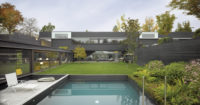Smiljan Radic may be best known for his 2014 Serpentine Pavilion in London, which resembled a seedpod resting on a group of flattened boulders. That left an impression of Radic, a RECORD Design Vanguard honoree in 2008, as a creator of primitive sculptural forms. But his latest building, a theater in Concepción, Chile, some 300 miles south of Santiago, explores a very different idiom, with a gridded concrete structure supporting a nearly rectilinear shell.
Asked about the dissimilarities, Radic said, “I don’t really care too much about the shapes of buildings. I start with the materials, and the atmosphere I want to create.” In this case, the primary material is PTFE, a Teflon-coated fiberglass. It’s not generally used for institutional buildings, Radic says, “because it seems impermanent, like a circus tent.” But that’s precisely what Radic was aiming for. The tentlike enclosure (less than an inch thick) would signal to residents of Concepción, heavily damaged in Chile’s 2010 earthquake, that this was a place for socializing and for fun, Radic explains. Of course the new building meets stringent seismic codes.
Called the Bio Bio Regional Theater (Concepción is the capital of the Bio Bio region), it contains a 1,200-seat main hall, a 250-seat secondary hall, and two 100-seat multipurpose rooms. Chile’s Ministry of Culture selected the Santiago-based architect through an international competition in 2011, and the completed building closely resembles Radic’s winning entry. It’s an important project to him, he says, because it serves a social need. (Much of his work, such as Casas Pareadas, is for private clients.) Though the program called for a regional theater, Radic, by adding public space inside the PTFE shell, increased the scale, and therefore the impact, of the building. Self-effacing but not without ambition, he says, “We tried to do something national and even international.”
By day, the building looks like a somewhat mysterious, solid object, with jaunty zigzags along the sides of the factorylike form. At night, it glows invitingly: “an advertisement that the theater is operating,” Radic has said. Behind the thin exterior, the expansive lobby is a kind of jungle gym of concrete columns and beams (all a slim 1113⁄16 inches square) as well as straight and spiral stairs and catwalks. Radic compares the aesthetic to “the scaffolding that holds up stage sets— something normally hidden.” He adds that it is “really austere, really crude. Things aren’t covered up with layers of materials.” The string of lights that snakes through the lobby is a work by the Chilean artist Ivan Navarro. Inside and out, the auditoriums are covered in blackened wood, in sharp contrast to the white of the exterior. The 107,650-square-foot building cost a modest $33 million, according to the architect.
Radic’s future output may not resemble either the “primitive” Serpentine Pavilion or the “rational” Bio Bio Theater. Before boarding a plane for Switzerland for the opening of an exhibition he curated (on the radical architecture of the 1950s, ’60s, and ’70s, at ETH Zurich Hönggerberg through May 18), he said of his next buildings, “I don’t think they have to be the same and the same and the same.”











Post a comment to this article
Report Abusive Comment